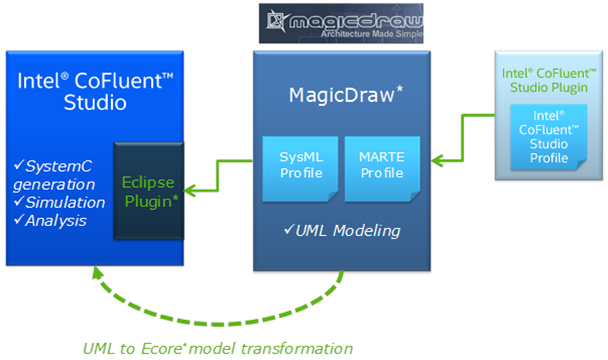
 This paper presents the Intel® CoFluent™ methodology for SysML and associated tool support. The methodology is based on UML with SysML and MARTE profiles. It allows automatic model transformation from this format to the Intel® CoFluent™ technology DSL.
This paper presents the Intel® CoFluent™ methodology for SysML and associated tool support. The methodology is based on UML with SysML and MARTE profiles. It allows automatic model transformation from this format to the Intel® CoFluent™ technology DSL.
The methodology can be seen as a set of modeling rules and restrictions applied to SysML/MARTE. These rules enable the simulation of multicore/multiprocessor hardware/software system models for behavioral and performance data prediction, without restricting the expressiveness of SysML and MARTE. The Intel® CoFluent™ methodology for SysML does not add new elements to standard profiles. It does, however, offer an optional profile to represent several features related to Intel® CoFluent™ DSL and necessary for efficient embedded system modeling and simulation.
An “Audio Video Player” example model is used to illustrate the design flow. This model is a high-level description of an audio-video decoder running on a generic platform. The generic platform consists of a processor and hardware accelerator.
Introduction
SysML is a UML profile that allows the creation of standard descriptions of a system. However, this profile is too generic to address embedded and real-time system design. The MARTE UML profile attempts to fill this gap by providing elements from both embedded software and hardware engineering. Unfortunately, it remains mainly descriptive in nature, since no commercial tools are available to simulate the models and extract performance data.
Intel® CoFluent™ technology offers methodology for SysML to provide comprehensive framework and guidelines for joint use of SysML and MARTE. The methodology offers simulation of multicore/multiprocessor hardware/software embedded system and chip models, enabling designers to observe the system behavior and analyze performance properties. The methodology delivers modeling rules and method with tool support.
Intel® CoFluent™ technology’s tool support includes:
- Intel® CoFluent™ technology UML profile extending UML 2.4, SysML 1.3 and MARTE 1.0 profiles
- Integration with leading UML modeling environments
- Link to Intel® CoFluent™ technology’s Intel® CoFluent™ Studio SystemC 2.3-based simulation environment for model execution and extraction of performance figures
The link to Intel® CoFluent™ Studio is achieved by model transformation from SysML to Ecore-based internal model description. The methodology for SysML complies with Intel® CoFluent™ Studio’s embedded system architecting flow and the MARTE profile’s intent that separates the application or functional view from the execution platform view. The execution platform view is often called the hardware resource view.
Hardware/software partitioning is described in a mapping or allocation view, and the resulting allocated view represents the actual embedded software threads executing on the various cores and operating systems that constitute the hardware and firmware. The resulting allocated view is a “virtual system”, since it encompasses the full hardware/software system.
Existing virtual platform and virtual prototype environments require the assembly of detailed intellectual property block models. Intel® CoFluent™ technology’s virtual system modeling and simulation technology overcomes many of the limitations of virtual platforms since it can be executed before detailed hardware intellectual property block models and embedded software are available. Thus, it removes the inherent limitations due to the availability of the models or their important development time and associated cost. The Intel® CoFluent™ technology also goes beyond traditional UML simulation that does not take into consideration architectural and non-functional performance dimensions such as thread priorities and scheduling, time constraints, bus transactions, memory accesses, power consumption, memory footprint, cost, etc. Virtual systems provide fast and accurate evaluation of various use cases and design scenarios by executing SysML specifications and predicting the behavior, performance and power consumption. Accurate prediction is critical for multicore and low-power designs.
Intel® CoFluent™ Studio with SysML support enables system designers to store and exchange design information internally and between third parties in a standard format. It allows the delivery of executable specifications and SystemC test cases for further system validation with SystemC-based virtual platform environments.
Prerequisite: The reader is assumed to have a basic knowledge of UML, SysML and MARTE technologies in order to fully understand this white paper.
UML Modelers and Intel® CoFluent™ Studio Integration
The Intel® CoFluent™ Application profile and associated Intel® CoFluent™ technology plugin are currently available for No Magic’s MagicDraw modeling tool.
The SysML/MARTE application model can be captured in MagicDraw and then imported from Intel® CoFluent™ Studio. MagicDraw can also be directly integrated into Intel® CoFluent™ Studio as an Eclipse* plugin, with one-click integration for the user, in order to work within a single modeling environment.
MagicDraw customization has been developed to ease the modeling guidelines application and the Intel® CoFluent™ profile usage. A MagicDraw validation module for Intel® CoFluent™ technology is available to ensure that the SysML/MARTE model is compliant to the methodology and can be transformed into an Intel® CoFluent™ model. All these elements are part of the Intel® CoFluent™ plugin for MagicDraw.
Full article:
An Intel® CoFluent™ Design White Paper By Thomas Robert and Vincent Perrier is published at http://www.intel.com/content/dam/www/public/us/en/documents/white-papers/cofluent-methodology-for-sysml-white-paper.pdf
